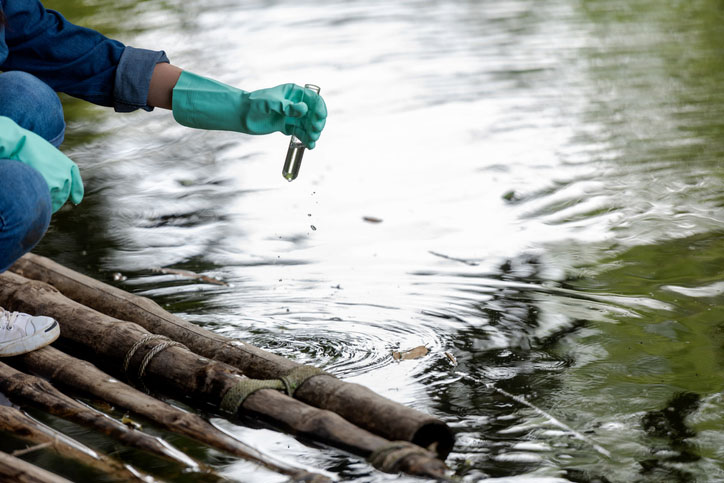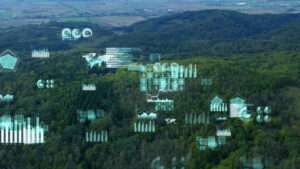Written by Scott Wilson

You’re used to seeing the headlines all on the same page these days: the latest amazing release of a new chatbot with superb voice recognition and natural language skills, right next to an article about the planet exceeding the critical 1.5-degree heat increase that could send it over the edge to oblivion.
In fact, there’s great debate both in computer science and in sustainability circles about the electrical demand of training those incredible AI models. Some estimates by researchers at the University of Massachusetts show that the emissions from a single training run for a large language model adds some 300,000kg of CO² to the atmosphere. That’s the equivalent of more than 150 passenger jet flights between New York and Beijing.
But the two fields don’t need to be in competition. In fact, there’s every reason to think that some of the advances in artificial intelligence may be a game-changer in the world of sustainability and environmental science. And that means for the world itself.
What Are Sustainability and Environmental Science?
 Environmental science has been around as a practical field since the early 1900s. The outgrowth of studies of the Earth’s atmosphere, environmental science connected all the complex pieces that go into climate, ecology, and public health.
Environmental science has been around as a practical field since the early 1900s. The outgrowth of studies of the Earth’s atmosphere, environmental science connected all the complex pieces that go into climate, ecology, and public health.




As pollution from the industrial era started to catch up with human populations in a big way, scientists started studying environmental protection and cleanup… and came across the awful equations leading the planet on a path to unsustainable warming.
Today, environmental sustainability is the holy grail for humanity’s continued existence on Earth.
Sustainability, at least in the environmental sense, has only been well-defined since the 1970s. A landmark United Nations report called “Our Common Era” laid out the risks of ongoing development in the present without accounting for their impacts in the future.
Taking the findings of environmental scientists and translating the requirements of a stable and livable world are the mission. The details are legion. But the stakes are existential.
How Artificial Intelligence May Help Change the Fate of the Planet
 Artificial intelligence seems almost tailor-made for diving into fields with unimaginably huge numbers of data points with subtle, but crucial, relationships. Machine learning algorithms can make short work of assessing and interpreting myriad data, from centuries worth of temperature readings to airborne pollutant levels to square kilometers of foliage coverage detected by infrared satellite imagery.
Artificial intelligence seems almost tailor-made for diving into fields with unimaginably huge numbers of data points with subtle, but crucial, relationships. Machine learning algorithms can make short work of assessing and interpreting myriad data, from centuries worth of temperature readings to airborne pollutant levels to square kilometers of foliage coverage detected by infrared satellite imagery.
AI plucks out trends and connections that human researchers might never find.
AI will be big on the computational side of environmental science. But it’s also a big help just collecting that data in the first place. Computer vision and image processing already powers satellite surveillance of ice pack coverage, jungle deforestation, and desertification. The smarter these systems get, the more detail they can pull from what they see.
AI is also being put to work on responses to environmental threats. Tracking the pollution trail is a job that involves a lot of big data. AI will be used to identify and sort waste products that could be recycled or require special handling for safe disposal. AI image recognition systems are already scanning waste streams for recyclables, and may soon be paired with sorting robots to pluck any recyclable item out instead of sending it to a landfill.
It’s not just detection and monitoring where AI will lend a hand, however. Breakthroughs in new solutions to some of the biggest problems in environmental health may come through applied artificial intelligence in areas like biochemical engineering and materials science. New genetically engineered organisms that can digest fuel or chemical spills and render them non-toxic may come from ML-driven bioengineering. And materials scientists are already using AI to try to develop substances more effective and efficient in carbon capture to trap and sequester greenhouse gas emissions.
Finally, AI is going to improve the fidelity and accuracy of environmental models. Not only will these be used to better forecast the outcomes of changes in industry and lifestyles, but they will help researchers identify areas most affected by environmental dangers… and help people from being caught in the ensuing catastrophes.
Jobs in AI in Environmental Science and Sustainability Are Already Appearing
 Positions for AI professionals working with environmental scientists will initially be mostly with universities and government and non-profit research laboratories. In fact, that’s already where they are beginning to appear.
Positions for AI professionals working with environmental scientists will initially be mostly with universities and government and non-profit research laboratories. In fact, that’s already where they are beginning to appear.
These organizations are already knee-deep in data science and other machine learning applications, so there may not be much of a transition for AI professionals. Jobs like Environmental Data Scientist and Machine Learning Engineer already exist in the field.
As artificial intelligence applications become more common, the objectives and titles in environmental jobs won’t change, but the skillsets will lean increasingly toward those built out by AI degrees.
For the most part, positions in this field are likely to stick to people who have advanced degrees in artificial intelligence. The research and tough theoretical work are best handled by people who have gone through similar projects in master’s or doctoral studies.
These positions build one-off models for specific research projects, or run and maintain systems that scientists can tap into continually. Other AI engineers and AI software developers will find work connecting artificial intelligence systems to existing modeling software. They may also be building tools that government officials and corporate managers will use to assess and mitigate environmental impacts.
Of course, sustainability work won’t be restricted to just government and university researchers. Positions in most industries will unfold to use AI to improve sustainability—it’s a good business proposition as well as a critical piece for the future of the environment.
AI engineers will put together systems that monitor and even manage corporate sustainability efforts, from recycling to energy monitoring to land use. These positions may not require the same high level of education as the research side of the field. They will need a much more grounded, business-oriented approach to sustainability AI, however.
Exploring the Best Artificial Intelligence Degrees for Work in Environmental Science and Sustainability
 Planetary ecology and climate may be the mother of all complex subjects. It’s the very place where the term butterfly effect comes from… tiny differences in initial conditions leading to massively different outcomes.
Planetary ecology and climate may be the mother of all complex subjects. It’s the very place where the term butterfly effect comes from… tiny differences in initial conditions leading to massively different outcomes.
Getting the education to make sense of not only climatological complexities but also the intricate and un-intuitive world of machine learning requires advanced and specialized studies.
So far, there are no degree programs in artificial intelligence that offer specific concentrations in the field of environmental science. But there are many existing specialization options that put you on the path to understanding that world. Degrees such as a Master of Science in Intelligent Systems Engineering Environmental Engineering track are tailor made for environmental science.
Environmental science is a big field with a lot of potential AI applications, however, so more specific degree concentrations may also make sense for some jobs. A Master of Science in Applied Artificial Intelligence Systems Biology concentration may be a good pick for biosphere impact modeling; a Master of Computer Science Computer Vision specialization would be a good fit for working with satellite imagery analysis of the polar ice caps.
Because of the concentration on data in environmental science, almost any AI degree concentration in data science is a good bet. A Master of Science in Artificial Intelligence concentration in Data Science and Data Analytics is one example.
Certificate Programs Can Put Transferable Knowledge from Other Degrees to Work in Environmental AI
 For students who already hold a degree with the required statistical, coding, and data science foundations, certificate programs are also available in most of these areas. An educational certificate packages up a handful of the same college courses found in those concentrations and offers them as a fast, affordable way to pick up knowledge.
For students who already hold a degree with the required statistical, coding, and data science foundations, certificate programs are also available in most of these areas. An educational certificate packages up a handful of the same college courses found in those concentrations and offers them as a fast, affordable way to pick up knowledge.
For someone who already has a strong familiarity with environmental sciences but wants to build up their AI credentials, a Graduate Certificate in Artificial Intelligence deliver a solid general understanding of ML, algorithm development, and artificial neural networks.
Professional certifications, a credential offered not by colleges but by industry standards organizations or tool vendors, don’t play a big role in environmental science AI. However, some specific professional certifications in machine learning or data science may help develop street cred in specific techniques for environmental modeling.
Combining the two big sciences most likely to impact the human race in the 21st century and beyond is inevitable. Making sure they work to benefit one another and improve the lives of billions is not inevitable… but well-trained, motivated AI engineers with strong environmental chops are the ones who could make it happen.






